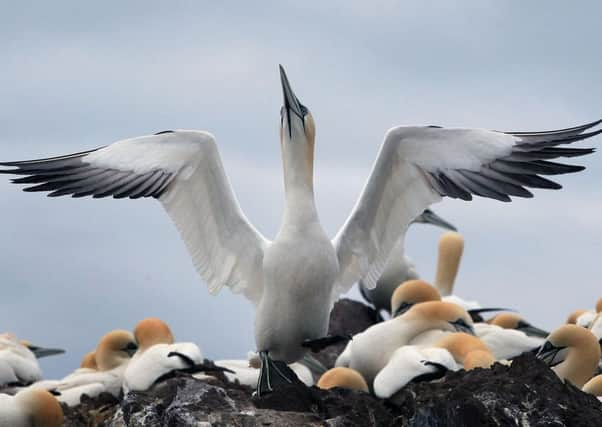Phil Taylor: We can all play part in survival of seabirds


Scotland’s seas are full of seabirds. Every spring, five million seabirds arrive at our coastlines, cliffs and islands to breed. More than 487,000 gannets make their way from a winter spent down the coast of Africa and the Mediterranean, a million puffins cross the Atlantic and 250,000 Manx shearwaters return from Brazil’s tropical waters. Places like St Kilda, the Fair Isle, Bass Rock and the cliffs of St Abbs fill up with a suite of stunning seabirds. Guillemots turn the cliffs Dalmatian as they queue up on precocious ledges, puffins form huge warrens, while gannets settle on anything they can find and defend it fiercely.
Amongst this vast seabird invasion we also see the arrival of seaducks and divers. Huge rafts of eiders form in the Firth of Forth for courtship and mating, and divers loon and breed along our sealochs making amazing evening spectacles. Even through the winter some of these birds still fill up our coasts; Coll and Tiree are an important refuge for eiders and our coastlines also welcome stunning long-tailed ducks and velvet scoters from their breeding grounds in the Arctic tundra. These birds characterise Scotland’s seas, they play a central role in our marine environment. Our seas are also internationally important for them, for example the Bass Rock is the world’s largest gannet colony while Rum is the world’s largest Manx shearwater colony.
Advertisement
Hide AdAdvertisement
Hide AdUnfortunately though, many seabirds are in decline. Since about 2000, we have seen a sharp drop in the numbers of kittiwakes, guillemots, Arctic terns and Arctic skua breeding along our coasts. Last year we also saw puffins moved up to “red” on the British Birds of Conservation Concern list. The reasons for these changes are complex, but appear to be related to the warming oceans which negatively affect the plankton communities, in turn affecting the fish communities. This ultimately results in seabird parents not being able to feed their chicks.
Clearly work to mitigate further warming is needed, and RSPB Scotland is investing a great deal into making progress with green energy and transport to combat climate change. However, in the short term, and in the local waters most important for these birds, something else is needed. Over the past few years RSPB Scotland has been working with the Scottish Government to identify and protect the most important parts of our seas. And, last month the government took an important stride forward. They proposed ten areas including Scapa Flow, the Sound of Gigha and the Ythan Estuary for official formal protection. A public consultation is now open to get your views about whether they need to be protected. We, at RSPB Scotland, will be responding to this consultation to ask that all ten sites are promptly designated and we would love it if you could support this call too. You can do so easily, by following the link at the bottom of this article to our marine e-action and adding your voice to the cause.
Our seabirds will soon be finishing their breeding cycle, with many thousands of adults and chicks heading out into the seas to warmer climes for winter. Many of the chicks will not return for a few years, I hope when they do come back, we can offer them a safer, healthier and better protected home.
• Phil Taylor, RSPB Scotland marine policy officer
• Join RSPB Scotland’s call for action here: {https://e-activist.com/ea-action/action?ea.client.id=13&ea.campaign.id=53264&ea.tracking.id=FotS|https://e-activist.com/ea-action/action?ea.client.id=13&ea.campaign.id=53264&ea.tracking.id=FotS|link to site]